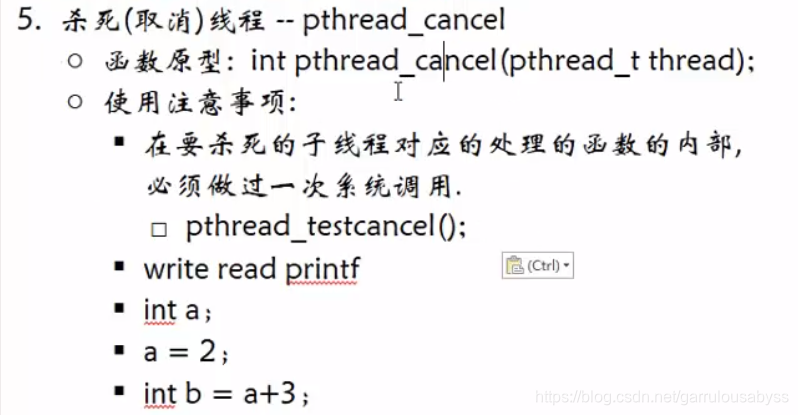七十一. pthread_exit函数的使用

pthread_exit.c
#include <stdio.h>
#include <unistd.h>
#include <stdlib.h>
#include <sys/types.h>
#include <sys/stat.h>
#include <string.h>
#include <pthread.h> //这里是线程对应的头文件
void* myfunc(void* arg)
{
//打印子进程的id
printf("child pthread id: %lu\n", pthread_self());
for(int i=0;i<5;++i)
{
printf("child i = %d\n",i);
}
return NULL;
}
int main(int argc, const char* argv[])
{
// 创建子线程
//线程ID变量
int ret = pthread_create(thid, NULL, myfunc, NULL);
if(ret != 0)
{
printf("error number: %d\n",ret);
//打印错误信息
printf("%s\n",strerror(ret));
}
printf("parent pthread id: %lu\n", pthread_self());
//退出主线程
pthread_exit(NULL);
for(int i=0;i<5;++i)
{
printf("parent child i = %d\n",i);
}
return 0;
}
运行结果,由于pthread_exit()让主线程退出,所以主程序最后的循环部分,并不会执行
[root@VM_0_15_centos 8Day]# gcc pthread_exit.c -o p_e -std=gnu99 -lpthread
[root@VM_0_15_centos 8Day]# ls
a.out p_e pthread_attr.c pthread_join.c
deamon.c process_r.c pthread_create.c pthread_uncle.c
loop_pthread_create.c process_work.c pthread_exit.c setsid.c
[root@VM_0_15_centos 8Day]# ./p_e
parent pthread id: 139925119584064
child pthread id: 139925111203584
child thread .....
child i = 0
child i = 1
child i = 2
child i = 3
child i = 4
注意,对于子线程的退出,应该用pthread_exit,而不该用exit(),因为exit()是让整个进程,而非仅此线程退出。
七十二. 使用pthread_join回收子线程资源

pthread_join.c
#include <stdio.h>
#include <unistd.h>
#include <stdlib.h>
#include <sys/types.h>
#include <sys/stat.h>
#include <string.h>
#include <pthread.h>
int number = 100;
void* myfunc(void* arg)
{
printf("child pthread id: %lu\n", pthread_self());
printf("child thread .....\n");
for(int i=0; i<5; ++i)
{
printf("child i = %d\n", i);
}
return &number;
//pthread_exit(&number);
}
int main(int argc, const char* argv[])
{
// 创建子线程
pthread_t thid;
// 返回错误号
int ret = pthread_create(&thid, NULL, myfunc, NULL);
if(ret != 0)
{
printf("error number: %d\n", ret);
// 根据错误号打印错误信息
printf("error information: %s\n", strerror(ret));
}
printf("parent pthread id: %lu\n", pthread_self());
// 退出主线程,子线程不受影响
// pthread_exit(NULL);
int *ptr;
pthread_join(thid, (void**)&ptr);
printf("++++++++++ number = %d\n", *ptr);
printf("parent thread .....\n");
for(int i=0; i<3; ++i)
{
printf("i = %d\n", i);
}
return 0;
}
运行一下
[root@VM_0_15_centos 8Day]# gcc pthread_join.c -o p_j -std=gnu99 -lpthread
[root@VM_0_15_centos 8Day]# ls
a.out p_e process_work.c pthread_exit.c setsid.c
deamon.c p_j pthread_attr.c pthread_join.c
loop_pthread_create.c process_r.c pthread_create.c pthread_uncle.c
[root@VM_0_15_centos 8Day]# ./p_j
parent pthread id: 140315507676992
child pthread id: 140315499296512
child thread .....
child i = 0
child i = 1
child i = 2
child i = 3
child i = 4
++++++++++ number = 100
parent thread .....
i = 0
i = 1
i = 2
七十三. 线程相关函数介绍


七十四. 设置分离属性

pthread_attr.c
#include <stdio.h>
#include <unistd.h>
#include <stdlib.h>
#include <sys/types.h>
#include <sys/stat.h>
#include <string.h>
#include <pthread.h>
void* myfunc(void* arg)
{
printf("child pthread id: %lu\n", pthread_self());
return NULL;
}
int main(int argc, const char* argv[])
{
// 创建子线程
//线程ID变量
pthread_t thid;
// 返回错误号
//初始化线程的属性
pthread_attr_t attr;
pthread_attr_init(&attr);
//设置分离
pthread_attr_setdetachstate(&attr, PTHREAD_CREATE_DETACHED);
int ret = pthread_create(&thid, &attr, myfunc, NULL);
if(ret != 0)
{
printf("error number: %d\n", ret);
// 根据错误号打印错误信息
printf("error information: %s\n", strerror(ret));
}
printf("parent pthread id: %lu\n", pthread_self());
sleep(1);
//释放资源
pthread_attr_destroy(&attr);
return 0;
}
七十五. 线程同步的概念

